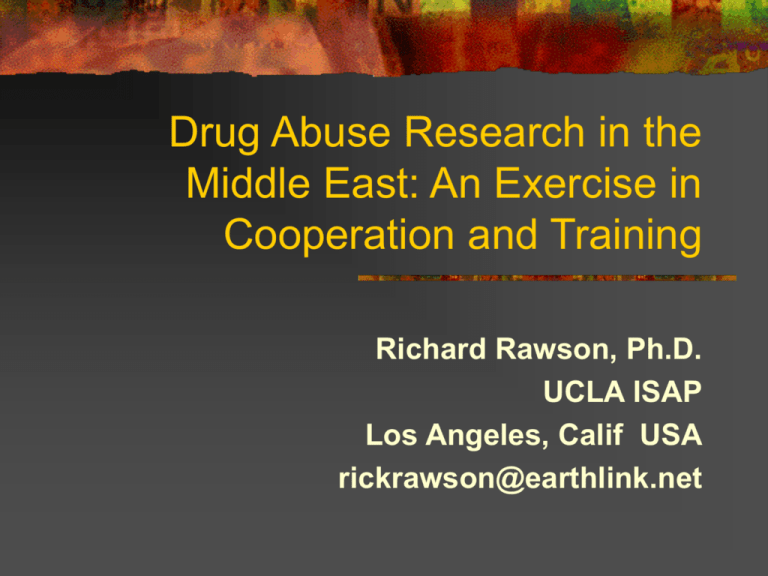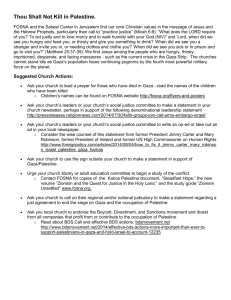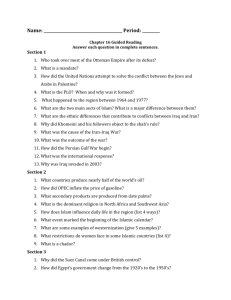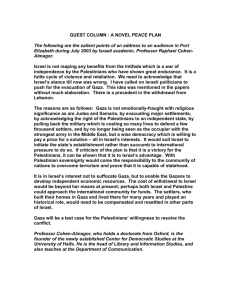Drug Abuse Research in the Middle East
advertisement

Drug Abuse Research in the Middle East: An Exercise in Cooperation and Training Richard Rawson, Ph.D. UCLA ISAP Los Angeles, Calif USA rickrawson@earthlink.net Drug Abuse Research In the Middle East: Acknowledgements Colleagues Palestine: Mohamed Afifi, MD Substance Abuse Research and Addiction Center (SARC), Gaza City, Gaza Israel: Richard Isralowitz, Ph.D. Ben Gurion University Beersheva, Israel Egypt: Nasser Loza, MD, and Ahmed El Dosoky, MD, Behman Hospital Cairo, Egypt Project funded by the Middle East Regional Cooperation Program, USAID Brief History UN creates Commission on Narcotics after WW2. In 1959 the Middle East Narcotics Survey Mission concludes: agreements between neighboring countries are essential should be liaison among gov’t agencies including health, education and social welfare ministries as well as NGO’s – No major evidence of cooperation and coordination until this experience Oslo Accord Oslo Accord – Sept, 1993 People to People (P2P) provisions set in place (Sept. 28, 1995) based on the guiding principle that political leaders cannot do it alone, social networks need to be built. Peace Process The aim of P2P was to create strong relations across broad networks of dedicated nongovernment individuals and institutions, thereby establishing a basis for the Palestinian-Israeli peace process. Key elements include: – promote short & long term transition efforts including cease fires, amnesty and mutual recognition – establish an infrastructure for communications and interaction building a peace constituency Drugs & Peace Aims Promote organization factors among the key participants in terms of 5 C’s: improve communications, cooperation and coordination of activities; minimize the conflict of negative national and regional issues and competition over scarce resources Build a bond between US/UCLA and Middle East drug experts Generate short and long term drug related activities geared to addressing individual country/people needs leading to a platform of regional cooperation. Drug & Peace Activities Regional Alcohol and Drug Abuse Resources center development (RADAR-SAMHSA) Workshop training – Pre-workshop training in Gaza and the West Bank in case borders are closed Beer Sheva workshop (1997) – border problems – finger pointing (addicts, informers, prostitutes, dealers being released, etc) Beer Sheva training (and threatened walkout but … 1998) Bethlehem workshop (Israeli security personnel stonewalled participation – however … 1998) Matrix/UCLA Manualized Treatment Protocols (in Hebrew and Arabic with MASHAV/PIN support) (1997-98) Activities Palestinian/Al Quds University workshop manualized treatment training (supported by the Israel Foreign Ministry – 1998) Beer Sheva follow up meeting with World Health Organization representation (1998) RADAR meeting in Irvine California (June 1999) UCLA/Friends Research Institute, Inc., US Agency for International Development/MERC proposal development meeting (June 1999) Publications:Isralowitz, R., Sussman, G., Afifi, M. Rawson, R. Babor, T. and Monteiro, M. (2001) Substance Abuse Policy and Peace in the Middle East: A Palestinian and Israeli Partnership. Addiction, 96, 102-114. Isralowitz, R. Afifi,M.and Rawson, R., Editors. (2002) Drug Problems: Cross-Cultural Policy and Program Development. Greenwood Publishing, Westport, Conn. Efforts to find research funding Middle East Regional Cooperation Program (MERC) MERC 1 – youth at-risk and drug use assessment/ NIDA Community Epidemiology Work Group participation (3 partners: Israel/Palestine/US) MERC 2 – Addiction Severity Index development (3 partners: Egypt/Israel/US) Planned MERC 3 – Lebanon (3 partners: Israel/Lebanon/US) US Institute for Peace Meeting Implementation of Palestine-Israel and Other MERC Grants Plans for extensive cooperative research training activities. Current Intifada begins Sept 2000. Trilateral cooperation dramatically curtailed/discontinued. Multiple bilateral training activities initiated with a goal of expanding training activities within each group. Epidemiology/Drug Use Monitoring Strategies Considered School surveys Household surveys Treatment program admissions Urinalysis results among arrestees Emergency room mentions Deaths Sampling Rationales Gaza: No data on anyone. Greatest interest in youth and adult offenders(data on this group impossible due to intifada conditions Israel: Considerable data on general population of youth and adults. Greatest interest in “high risk youth” Egypt: Rapid assessment completed. Greatest interest in a sustainable monitoring system Report of High Schools Survey for Drug Use in Gaza Strip 2003 Joint Project: SARC-Palestine , UCLA, BGU University Financed by USAID Agency M.Afifi, S.Sousi, Z.AbuRsas Introduction: Gaza Strip - Geography Area = 362 sq.km Located in South West of Palestine (Israel) at the Mediterranean 50 km long and (5-12 km width. Borders: West (Sea), North and East (Israel), and South (Egypt) 25% occupied by Israeli settlements. School System and High Schools Distribution Introduction: Elementary schools (age 6-12 years) Preparatory schools (age 13-15 years) Secondary (high) schools (16-18 years) There are 70 high schools in Gaza Strip (33 schools for boys, 37 for girls), with total of 54695 students. (27015 boys, and 27680 girls). Cultural Environment in Gaza Very conservative values Parental control is strong Due to security restrictions, availability of drugs is limited Data Collection Instrument SUSI Substance Use Survey Instrument (Modified version) (28 simple questions about drug and problem behaviors) Reports on actual use virtually zero; Questions concern those who know of a same aged peer who uses Study Cohort (N=1,034) The students sample consisted of class units (one randomly selected class of grade 11). 26 high schools were chosen (14 boys schools and 12 girls schools). The total is 1034 students. Tobacco 17.2% of the boys 7.9% of the girls Observed smoking in schools:34.2% Observed smoking in districts:46.7% Age of first use (years): 13 for boys and 15 for girls. Prescribed medicines 2.5% of the boys 5.6% of the girls Observed using in schools:3.2% Observed using in districts:5.2% Age of first use (years): 14 for boys and 15 for girls Inhalants 6.4% of the boys 2.6% of the girls Observed using in schools:% Observed using in districts:% Age of first use (years): 13 for boys and girls Summery of How Easy to Get Drugs 57.9 95.8 Pr Be es er c.d ru gs M ar ij 5.2 9.1 6.1 13.8 Ci g Boys Girls 27.8 27.1 96.6 100 90 80 70 60 50 40 30 20 10 0 43.3 Easy to Get % Results: Po wd er Training Activities as a Component of Research: Palestine Training in survey instrument construction Training in survey methods Training in human subjects/confidentiality issues Training in management of research data Training in data analysis Training in publication and presentation methods Clinical training done in Egypt High-Risk Youth and Drug Use: Toward an Early Warning System of Problem Behaviors Richard Isralowitz, Ph.D. Director Regional Alcohol and Drug Abuse Resources Center Israel Population 6.5 million (about 10% living abroad; 18% of the immigrants are from the FSU since 1989; 18% are Israeli Arab citizens….) Geographic Area The size of New Jersey (20,770 sq/km) Borders Egypt, Jordan, Syria, Lebanon, Gaza, West Bank Data Collection Instrument SUSI Substance Use Survey Instrument (28 simple questions about drug and problem behaviors) Study Cohort (N=1,019) Probation Youth (102) Other High Risk Youth (917) (immigrants, youth in alternative special education/training programs, street youth, and those from low-income neighborhoods) TOBACCO 30% report smoking cigarettes (67% of probation youth are cigarette users) age of first use – 13 years most smoke 11-15 cigarettes per day on average, $11/week is spent for cigarettes ALCOHOL age of first use – 13 years last 30 day use: beer 53% - wine 42% - hard liquor 37% - 28% binge drink ( 5 or more drinks/occasion) Age at First Use 20 me dia n 18 16 16 14 15 14.2 15 14.8 13 12.7 13 12 ye ars a ve ra ge 12.5 14.9 15 14.9 13 11.9 12 11.7 10 8 6 4 2 0 r Be e r e a na quo i Win u j i L r d Ma Ha r s s h is h ru g s la n t D a a n h H In t io cr ip s e Pr ta Ec s sy Youth Drug Use: Last 30 Days 70 P roba tion Youth 65 Othe r High Ris k Youth 60 52 50 47 46 41 40 36 % 30 20 15 9 10 5 9 4 6 4 4 2 0 Be er a e or ua n Win d Liq u j i r r Ma Ha s is h n ts ru g h a l s D a Ha io n In h t p i s cr e r P ta E cs sy 2 Training and “Cooperation” Activities: Israel Encouraging cooperative activities between Israeli administrative entities (Universities, treatment agencies, Ministry of Health, Mental Health and Social Welfare. Training in CBT and MI Adoption of the ASI and ASI clinical report into Hebrew. Training in the use of the ASI Training on models of treatment for co-occurring substance abuse and mental health disorders Egypt: A Drug Abuse Monitoring System Pilot testing of a data collection system on admissions to 4 substance abuse treatment programs in Cairo Modified version of the Addiction Severity Index. Data collection just begun Training and Cooperation Activities: Palestine and Egypt Palestinian team brought to Egypt for 3 months of training in clinical procedures (MDs, psychologists, nurses) Palestinians on all Egyptian project steering committees. Palestinians participate in all Egyptian training activities Training and Cooperation Activities: Palestine and Egypt University grand rounds Community presentations Cairo Meetings Sept 23-Oct 3 2004 WHO Sept 23: New research findings U of Cairo Sept 25: Pharmacotherapy advances Ain Shams Sept 26: Co-occurring disorders UNODC: Empirically-based treatments Behman Hospital Sept 28-29: Intensive training in behavioral treatments Royal College of Psychiatry Oct 3 Participants: Many Egyptian groups, WHO, UNODC, NIDA, UCLA, U of Penn Lessons learned about research on drug use in the Middle East Drug abuse is a concern in all cultures, even in those areas with low rates of use. Development of strategies to prevent and treat substance use are activities that can be done across cultures. Drug abuse research is an endeavor that can be used to build cooperation and a vehicle for extensive training






